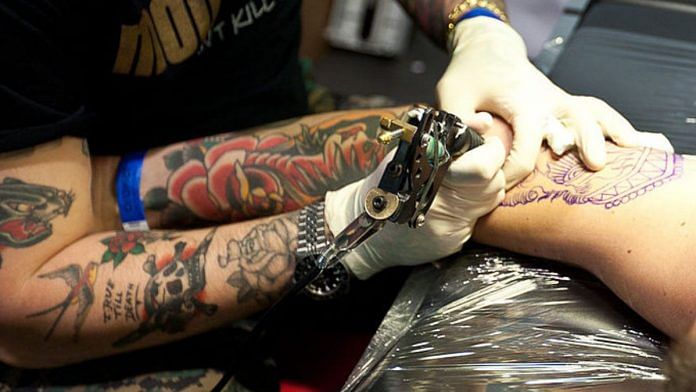The use of colour-changing fabric has been suggested for military use, where camouflage fabric—as uniforms or as material that hides ammunition—can be customized to change colour depending on the ambient temperature.
Research into ‘adaptive camouflage’, which ‘refers to the adaptation of an object, such as a military vehicle or soldier, to its surroundings’, in a study by Martina Vikova and Marcela Pechova, has focused on ‘the development of an adaptive color changeable system based on selected thermochromic inks following the colors used in Czech woodland and desert combat uniforms. The printed color pattern mimics leaf design, which transforms into desert design based on thermal conditions (hot air and body temperature).’
In another article from the Journal of The Textile Institute, the authors ‘have developed color changeable (chameleon-type) printings on cotton fabrics using thermochromic colorants for defense applications. Different colored coatings, such as light green, dark green, black, brown, and sandal have been developed using blue and orange thermochromic colorants in combination with turmeric (a natural dye) and graphite. The printed color pattern mimics jungle motif design (classic green and brown camouflage) which transforms to desert color motif on application of heat from external sources (using hot air oven or electrical power). The response time and temperature for each color change and recovery were evaluated in case of direct heating. The printed fabrics’ physical properties, such as tensile strength, elongation at break, flexural rigidity, and tear strength, were also tested before and after printing. The wash property of printed fabrics shows reasonably good fixation of colors to the fabric surface. The chameleon-type camouflage printing described in this work shows promise to use the same fabric for camouflaging at different terrains which essentially reduces the time for shifting troops to different locations.’
Dynamic Tattoos
Another example of a parallel drawn from the fashion and style industry to develop an exprovement is tattooing.
This age-old form of creativity and self-expression has found application in the wellness and medical industries in the form of colour-changing tattoos that, in conjunction with other technology, could help detect a number of conditions, from elevated alcohol levels to skin cancer.
Here are a few examples:
- In 2016, the Wall Street Journal reported that ‘Researchers at the Center for Wearable Sensors at the University of California, San Diego, have come up with a removable electronic tattoo that can sense your blood-alcohol level from the sweat on your skin and then send this information via Bluetooth to a smartphone or car computer.’Some of its potential applications include locking a car’s ignition if worrisome alcohol levels have been detected in the driver, notifying a recovering alcoholic’s sponsor if alcohol has been consumed, letting a bartender know if a customer has had too much to drink or simply providing a user who’s concerned about their own drinking habits with a visual indicator if they’ve crossed the drinking threshold.
- Combining nanotechnology with invisible tattoos, Carson Bruns, Assistant Professor, Laboratory for Emergent Nanomaterials, ATLAS Institute, along with the team at ATLAS has developed a tattoo ink that contains a UV-activated dye inside a plastic nano capsule that is several sizes smaller than the width of a human hair. These UV-sensitive tattoos turn blue when the tattooed individual has been exposed to too much sunlight and serve as a signal to apply more sunscreen or to reduce time spent in the sun. The hope is that this exprovement can lead to a reduction in skin cancer cases.‘When you think about what a tattoo is, it’s just a bunch of particles that sit in your skin . . . Our thought is: What if we use nanotechnology to give these particles some function?’ says Carson Bruns.
- In 2018, scientists at the Department of Biosystems Science and Engineering at the Swiss Federal Institute of Technology ‘created a tattoo comprised of engineered skin cells and an implantable sensor, which could detect elevated blood calcium levels that are present in many types of cancers.’ This smart-tattoo uses biosensitive ink and changes colour to indicate the presence of breast, colon, lung and prostate cancers. It could help recognize cancer in patients before it develops to the tumour stage, thus improving chances of recovery and potentially saving lives.
- In 2019, it was reported that scientists at the Technical University of Munich had developed ‘an intradermal tattoo that can change colour in response to changing levels of glucose, albumin, or pH’, biomarkers whose abnormal levels could indicate diseases related to the kidney, liver, heart (albumin), blood (pH) or help in the management of diabetes (glucose).
While most smart tattoo applications are still under laboratory trials, they hold the potential to serve as indicators of a medical condition much more quickly, rather than realizing it only when a symptom shows up.
Life-Saving Dot
Our last example is not related to colour-changing material, but it is an example of how a traditional Indian symbol, which has developed into a fashion and style element over the years, was transformed into a device that could supply women with a vital nutrient they’re likely not getting enough of, especially in rural India.
The bindi, often seen on the foreheads of Indian women, dates back to the third or fourth century and is worn either for religious purposes or to indicate that one is married. In modern day India, however, it is commonly used as a mark of beauty and a fashion accessory, and is available in a plethora of colours, shapes and designs to match one’s outfit.
Thanks to the Jeevan Bindi or Life Saving Dot initiative by Neelvasant Medical Foundation and Research Centre, India, Grey For Good (the philanthropic arm of Grey Advertising) and Talwar (a prominent bindi distributor), the bindi could serve an additional purpose—provide women with iodine, a nutrient whose deficiency has been linked to depression, weight gain and brain development of foetuses during pregnancy.
‘India is one country where iodine deficiency is a real threat. Many of its residents are vegetarian, and the soil is notoriously poor in the mineral. This combination of factors means that rural women in particular are at risk of suffering from iodine deficiency.’ The group came up with the idea of coating the back of the bindi with iodine, which can be absorbed by the skin. As a result, a user can get up to 12 per cent of her daily iodine requirement, while staying stylish as well.
 This excerpt from Exprovement: Exponential Improvement Through Converging Parallels by Hersh Haladker and Raghunath Mashelkar has been published with permission from Penguin India.
This excerpt from Exprovement: Exponential Improvement Through Converging Parallels by Hersh Haladker and Raghunath Mashelkar has been published with permission from Penguin India.






